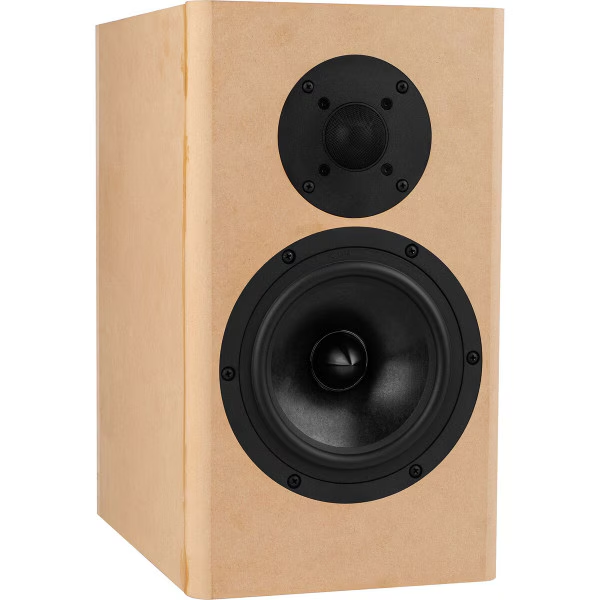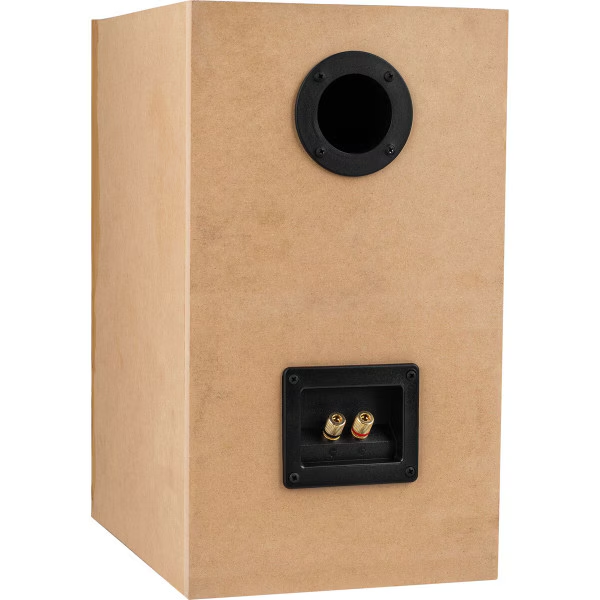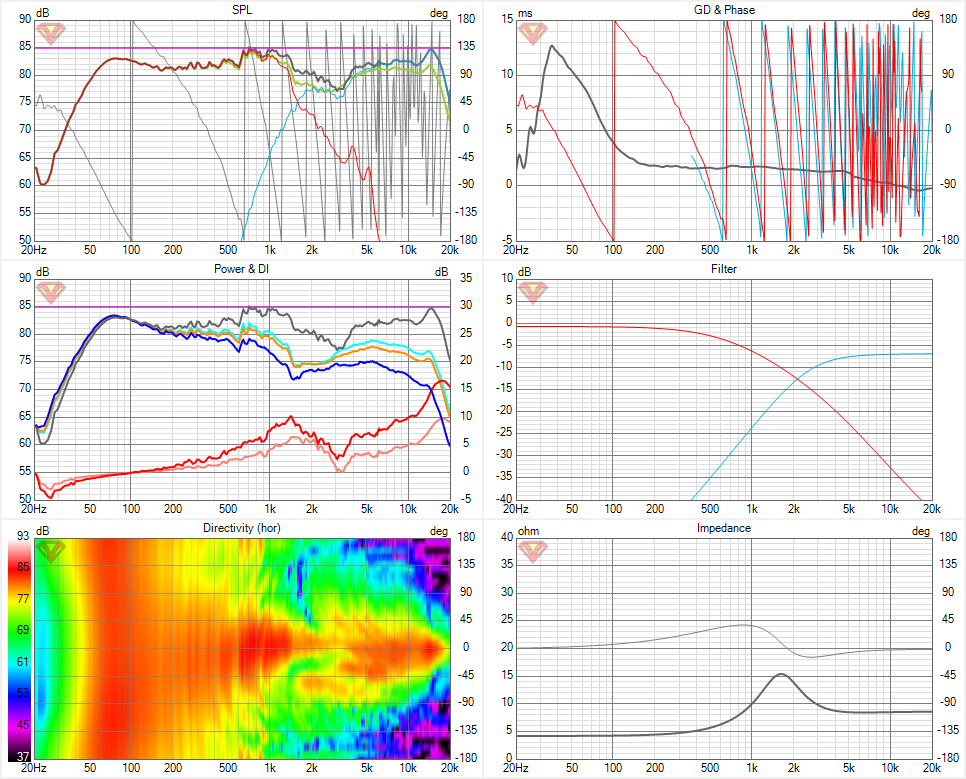

Parts-Express Samba MT
A Ported 2-Way from Parts-Express
Designed by
GorchPortley
Specifications
- Power Handling
- 120W
- Impedance
- 4Ω
- Plans Price
- $0.00
- Estimated Build Cost
- $165.00
- Category
- Two-Way
- Design Enclosure Files:
- 1
- Design Electronics Files:
- 1
- Design Other Files:
- 0
Dayton Audio - RS180P-4
- Frequency Files:
- 74
- Impedance Files:
- 1
- Other Files:
- 0
Dayton Audio - RST28F-4
- Frequency Files:
- 74
- Impedance Files:
- 1
- Other Files:
- 0
The Below is an excerpt from the Parts-Express product page for the Samba (this link takes you to a full kit available for purchase from Parts-Express, which simplifies the build process significantly, Highly Suggested):
Designed by the engineers at Dayton Audio, the Samba speaker kit is a compact 2-way bookshelf speaker that provides a reference quality sound without the usual high price. The Sambas produce an extremely detailed and accurate sound while still delivering a natural and non-fatiguing quality that is perfect for long listening sessions. Both the woofer and tweeter use low distortion motors and non-resonant diaphragms to deliver accurate sound that allows the speakers seemingly disappear into your listening environment. The Samba speaker kit will be right at home in everything from a high-end recording studio to any audiophile's living room.
The Parts Express Samba MT is a notable two-way bookshelf speaker design, leveraging high-quality components and advanced acoustic engineering to deliver reference-quality sound. This overview serves as a comprehensive repository of information about the Samba MT design, detailing the enclosure, crossover, woofer, tweeter, and port characteristics. It provides technical insights and practical advice for audio enthusiasts and DIY builders looking to understand or replicate this sophisticated audio system.
Enclosure
The enclosure’s external dimensions are about 15″ H × 8.5″ W × 11.75″ D, yielding roughly 0.5 cu ft of internal volume (after accounting for bracing and driver displacement). This relatively compact, bookshelf-friendly size still provides enough volume to support bass extension into the 40 Hz range, as we’ll discuss in the Port section.
Internally, the Samba MT cabinet should feature horizontal braces tying together the front, back, and side walls. This bracing, combined with thick panels, controls resonance.
Damping material is suggested to absorb internal reflections and midrange energy, preventing “boxy” coloration. Some hobbyists even experiment with adding a bit of polyfill or additional foam, but the stock damping of lining the walls with 1/2" acoustic foam is suggested for the intended bass response.
The design fully accounts for baffle step compensation (BSC) in the crossover – meaning the baffle width (8.5″) and resulting bass dispersion loss are compensated by boosting the speaker’s lower frequencies about 6 dB. In practice, this means the Samba MT is voiced for free-space placement, and you can place it on stands or away from walls without the bass thinning out. If you do place the speakers near boundaries (wall or shelf), expect strong bass; some builders in tight spaces have opted to slightly adjust port tuning or add stuffing to tame potential boominess, but in most rooms the stock tuning yields a pleasing balance.
Crossover
The crossover point is approximately in the 2 kHz range (where the woofer’s and tweeter’s outputs overlap and sum). This frequency was chosen to balance the dispersion and power handling – it’s low enough to avoid the woofer beaming too much, yet high enough to keep the tweeter comfortable and out of distortion. Both drivers’ “low distortion motors” and smooth roll-offs help in this regard.
The Samba MT uses a second-order filter topology (12 dB/octave slopes) on both the woofer and tweeter, combined with some response-shaping elements. From the included parts we can infer the network: the woofer circuit employs a 1.2 mH air-core inductor in series to low-pass the woofer, and a 7.5 µF capacitor (with a resistor) likely in parallel to shape the upper mids. Indeed, the crossover implements the full BSC by bleeding off midrange through a shunt network (a 7.5 µF cap in series with a 4.7 Ω resistor across the woofer) – this attenuates the woofer’s output above a certain frequency, effectively shelving down the mid and treble by ~6 dB to match the baffle loss.
The tweeter’s high-pass uses the other 7.5 µF capacitor in series, paired with the 0.25 mH inductor to ground, forming a 2nd-order high-pass filter. The tweeter level is adjusted with an L-pad: the 1 Ω and 4.7 Ω resistors are used to pad down the tweeter’s higher sensitivity and ensure the combined system is around 87 dB/2.83V@1m.
The exact configuration (whether 1 Ω series + 4.7 Ω parallel or vice versa) yields a few dB of attenuation so that the tweeter’s output integrates smoothly without overpowering the woofer. This also helps the Samba achieve its “natural high frequency response”, avoiding any harsh brightness.

Modifications
For tweakers, the Samba MT’s crossover provides a great platform to experiment. Some advanced builders have tried replacing the passive network with an active crossover/DSP, essentially bi-amping the woofer and tweeter and using something like a miniDSP to dial in their own target curve.
On the passive side, hobbyists have swapped resistor values to slightly brighten or soften the treble to taste, or experimented with higher-end capacitors, etc. The general consensus, however, is that no major changes are needed – the included components are well-chosen, and any significant rework would essentially be redesigning the speaker. If you do want to tinker, you can take comfort that the community has measured data (Erin provided raw driver measurements included in the Design Snapshot) so you can simulate crossover alterations before heating up your soldering iron. For example, reducing the tweeter’s padding resistors could add some sparkle, or adjusting the woofer’s R+C shunt could bring the mid forward – but any such changes should be done with careful listening and possibly measurement, as they can affect more than just one aspect of the sound.
The Samba MT from Parts Express features the Dayton Audio RS180P-4 woofer, a 7" driver renowned for its high performance and smooth tonal quality. This woofer, part of the Reference Series, employs a paper pulp diaphragm that's treated for enhanced rigidity, leading to well-damped vibrations and a linear response. Its standout features include dual copper shorting rings that minimize voice coil inductance, thereby reducing distortion and maintaining clarity, especially in the midrange.
Designed for both low distortion and high excursion, with a maximum one-way excursion of 6 mm, the RS180P effectively manages air movement to produce deep bass down to approximately 40 Hz in typical room settings. Despite its moderate sensitivity, this woofer compensates with significant bass extension and can handle power up to 70 W RMS (140 W max), allowing it to reach peak levels of around 105 dB.
The robust construction includes a black pressed paper cone and a rubber surround, housed in a cast aluminum frame which prevents resonance, ensuring clean sound reproduction across the 45 Hz to 2 kHz frequency range it covers. This design ensures articulate and smooth midrange performance, free from the harshness seen in less optimized systems. The inherent damping of the paper cone eliminates the need for aggressive notch filtering, facilitating a more natural transient response and contributing to the woofer's ability to deliver a flat and neutral midrange.
Handling the treble in the Samba MT is the Dayton Audio RST28F-4 tweeter. This is a 1-1/8″ (28 mm) fabric dome tweeter from Dayton’s Reference Series, and it was a natural choice to pair with the RS woofer. Dayton actually developed this “RST” tweeter line as successors to their older RS28 series, with improvements in the motor and faceplate. The RST28F features a silk/fabric dome (black cloth with a damping coating) that provides a smooth, extended response. The slightly larger-than-standard dome size (most domes are 25 mm) allows for a lower resonance frequency and potentially lower crossover point, which is useful in a design like the Samba that crosses around 2 kHz. According to Dayton’s spec, the RST28F-4 has an Fs around 700 Hz, which is well below the crossover frequency – a good margin to ensure the tweeter isn’t stressed at the low end of its range.
The dome is centered in a round faceplate about 104 mm in diameter, with a shallow waveguide-ish recess. While it’s not a full waveguide, the curved profile around the dome does help control dispersion a bit and provides a nice flat surface to mount (and countersink) into the baffle. In terms of performance, the RST28F-4 is known for its detailed yet smooth character. It extends out to 20 kHz and beyond with no significant breakup modes – fabric domes tend to have a gentle roll-off in the top octave rather than a spiky resonance. The Samba’s measured treble is very flat through the presence band (2–10 kHz) and just a slight lift in the highest frequencies, which gives a sense of “air” without harshness.
One advantage of the 28 mm dome is slightly wider dispersion at the low end of its range (since a larger dome can control directivity a bit lower than a 25 mm). At 2 kHz, this tweeter can still spread sound fairly broadly, matching the woofer’s dispersion at that frequency, which helps the off-axis response remain smooth through the crossover. At very high frequencies (>10 kHz), the dome’s dispersion narrows somewhat (as all domes do), which reduces very high treble energy to the sides. This is usually not an issue in-room and can even be beneficial by reducing excessive sparkle in reflective rooms. The overall directivity pattern of the Samba is well-behaved, thanks in part to this tweeter – the horizontal off-axis curves are smooth, meaning you have a wide sweet spot. Importantly, the RST28F tweeter is designed to handle the low crossover point.
With ferrofluid and a robust 28 mm coil, it can comfortably play loudly at 2 kHz without compression. The Samba’s crossover uses a second-order electrical filter, which likely yields an acoustic slope near fourth-order (24 dB/octave) considering the tweeter’s natural roll-off. So by the time you go an octave below the crossover (~1 kHz), the tweeter is significantly attenuated, protecting it from over-excursion.
Reviews (1)
A Speaker with Killer Stereo Imaging
You need to be logged in to write a review.
Log in to write a review